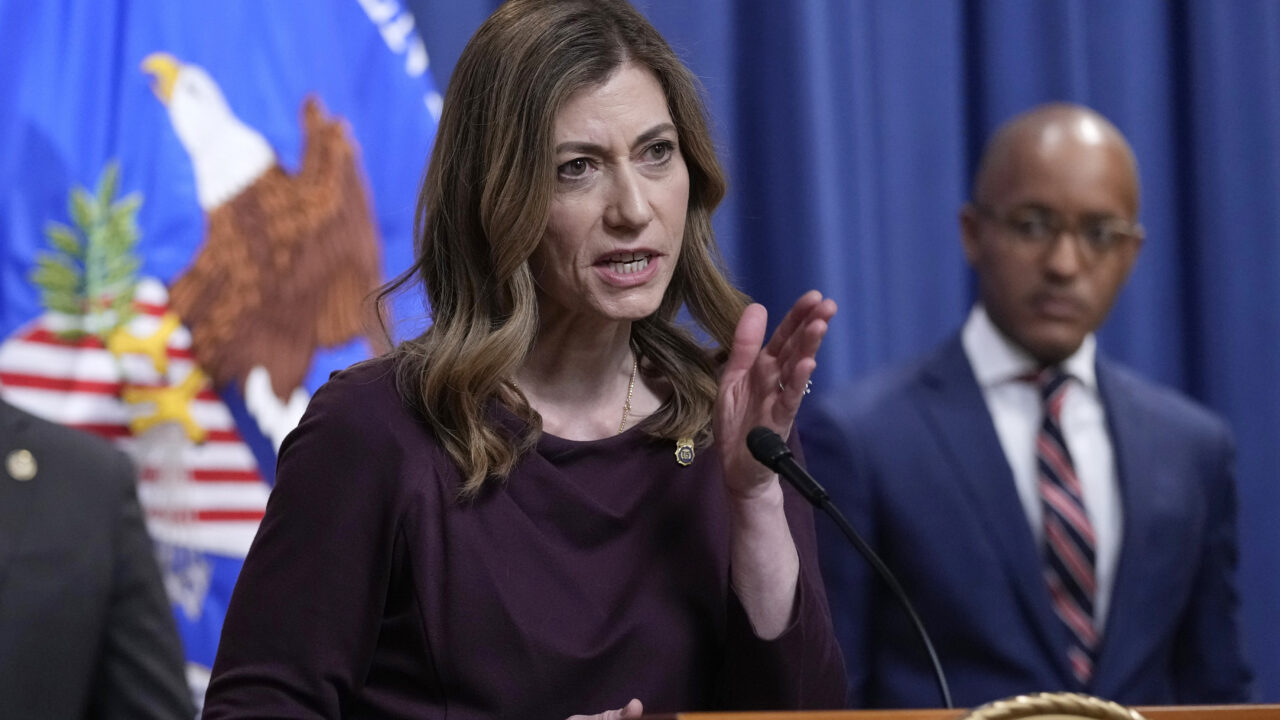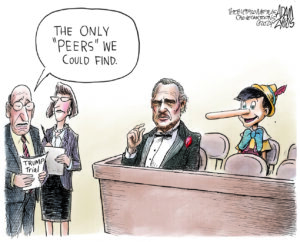Fentanyl Indictments Unsealed for El Chapo’s Sons
Five takeaways from the U.S. indictments of the Chapitos, the sons of former Sinaloa Cartel leader known as "El Chapo." DEA Administrator Anne Milgram, left, speaks during a news conference at the Justice Department in Washington, Friday, April 14, 2023. Photo: Susan Walsh / AP.
DEA Administrator Anne Milgram, left, speaks during a news conference at the Justice Department in Washington, Friday, April 14, 2023. Photo: Susan Walsh / AP.
US prosecutors have taken aim at one of Mexico’s most powerful drug trafficking enterprises, the Chapitos, in a series of indictments that reveal the history of the group and the global evolution of the fentanyl trade.
The five indictments unsealed on April 14 come from three US federal court districts: the District of Columbia in the nation’s capital, the Northern District of Illinois in Chicago, and the Southern District of New York in Manhattan.
The documents detail the criminal actions of Iván Archivaldo Guzmán Salazar, Jesús Alfredo Guzmán Salazar, Ovidio Guzmán López, and Joaquín Guzmán López. The brothers, collectively known as the Chapitos, are the children of former Sinaloa Cartel leader, Joaquín Guzmán, alias “El Chapo.“
The indictments also level allegations against various associates and allies of the Chapitos across a vast geographic spectrum and time period.
The charges are not uniform for all the brothers. The federal prosecutors in Chicago named all four sons as the Chapitos, while those in Manhattan named just the first three as the Chapitos, charging Iván Archivaldo and Jesús Alfredo in one indictment and Ovidio in a separate indictment.
They are also very different charges. The Chicago-based prosecutors charged the four brothers with cocaine, methamphetamine, and heroin trafficking, among other crimes, and interspersed headline-grabbing details that include tigers eating people alive. The New York prosecutors, however, charged three of the brothers and numerous accomplices with trafficking fentanyl, and provided many details of the network’s modus operandi and history.
Mexican criminal groups like the Sinaloa Cartel, in large part because of how strict regulations are regarding methamphetamine precursors, have become self-sufficient producers of some of the highest quality methamphetamine in the world.
Below, InSight Crime explores five major takeaways from the indictments.
1. The Chapitos Became the Chapitos in 2008
In 2008, according to the Chicago prosecutors, the Chapitos sent 10 tons of cocaine along the “Pacific” to the United States. Shortly thereafter, they allegedly moved another 5 tons along this same Pacific route. These shipments happened as part of the broader drug trafficking operations of the Sinaloa Cartel, founded by their infamous father.
The timing is important. In January 2008, Mexican authorities captured Alfredo Beltrán Leyva. Shortly thereafter, they released Iván Archivaldo Guzmán Salazar on a technicality. The Beltrán Leyva Organization (BLO) took this as a sign that El Chapo, who was not incarcerated at the time, had traded authorities Alfredo for Iván.
War followed. Hundreds died, including another of Chapo’s sons, who was killed by a hail of gunfire as he exited a shopping mall in Culiacán, the capital of the state of Sinaloa. Amid this family turmoil, the Chapitos were apparently born, cutting their teeth in both the art of war and the art of business.
These days, the Chapitos are literally everywhere. Prosecutors in Chicago say they operate in Colombia, Ecuador, Venezuela, Peru, Panama, Costa Rica, Honduras, Guatemala, and, of course, Mexico. They were also in Texas, Illinois, California, New Jersey, and Arizona, among other places, moving cocaine, meth, and marijuana. The New York prosecutors, meanwhile, say they have a presence in 45 countries.
2. Fentanyl Synthesis in Mexico Began in 2014
According to the New York prosecutors, the first fentanyl synthesis in Mexico happened in a “modest house in Culiacán” under the Chapitos’ watch. This was followed by more experimentation in a clandestine lab in the neighboring state of Durango that was being used to make methamphetamine, prosecutors say.
These are incredible assertions for many reasons, not the least of which is because, to this day, Mexican authorities, including Mexican President Andrés Manuel López Obrador, insist that Mexican criminal groups are not synthesizing fentanyl in Mexico.
It is also incredible because of this alleged date of inception. Fentanyl use in the United States took off in 2014. US overdose statistics from 2015 were the first inkling of the breadth of the problem, and it has only grown since then, putting the Chapitos at the forefront of the fentanyl crisis.
However, while that narrative may be popular in Washington, the reality may be slightly more complicated. At the onset of fentanyl use in the US, the fentanyl was produced in China and shipped directly to the US without any participation from Mexican criminal organizations.
What’s more, the Chapitos in 2014 would have been in their 20s and 30s—a particularly young age to have the foresight to begin developing fentanyl on their own well before the Chinese government began strictly regulating fentanyl and fentanyl analogues, which did not happen in earnest until 2019.
Still, this may be true as it relates to the Sinaloa Cartel writ large, particularly since a similar process played out with regard to methamphetamine. Today, Mexican criminal groups like the Sinaloa Cartel, in large part because of how strict regulations are regarding methamphetamine precursors, have become self-sufficient producers of some of the highest quality methamphetamine in the world.
3. The Chapitos Seek ‘Monopoly’ on Fentanyl in Mexico
They “control and operate a significant percentage of the [Sinaloa] Cartel’s labs,” according to Manhattan federal prosecutors. And they have set up a distribution “outpost” in Mexico City where they could sell finished fentanyl to other parts of their organization and other organizations to mix with legacy drugs like heroin.
This is somewhat different from what InSight Crime has found in years of investigating synthetic drugs. Our sense, without necessarily having access to wiretaps and cooperating witnesses, was that these networks were more independent.
However, the New York prosecutors’ narrative speaks to strict control.
“In Spring 2022, Ovidio Guzmán López noted that he was working to centralize all fentanyl manufacturing in Sinaloa,” one indictment says, “effectively establishing a monopoly for the Cartel over the fentanyl market in Mexico.”
There are some variations of this. The New York indictment of the Chapitos makes clear there are several factions of the group that “run their own network of labs.” Still, others use the “same shared group of cooks” to synthesize fentanyl, prosecutors say.
Much of the fentanyl and fentanyl precursors arrived via Mexico’s international airports, including those in Mexico City and Guadalajara.
4. Precursor Market Managed by Brokers
The New York indictment identifies Ana Gabriela Rubio Zea, a Guatemalan national, as one of the group’s primary brokers for precursor chemicals. Rubio, according to prosecutors, works with Chinese chemical producers who have operations in Wuhan and other provinces that were not identified. Prosecutors did, however, identify Jiang and Yonghao Wu, alias “Tim,” as the “China-based middlemen” and Wuhan Shuokang Biological Technology as their company.
These precursors had different routes. Some went directly to Mexico “disguised in food containers, or packaged along with legal chemicals,” often via “Chinese air carriers.” But they “typically” went via Germany, a middleman noted. Still others went via the US, including Alaska and California. Much of the fentanyl and fentanyl precursors arrived via Mexico’s international airports, including those in Mexico City and Guadalajara.
5. US Fentanyl Wholesale Market Could Be Worth Up to $3 Billion
The New York prosecutors say the Chapitos and their associates are selling counterfeit drugs laced with fentanyl for roughly $1 a pill in the United States. They also say the Chapitos and associates are selling a kilogram of fentanyl for roughly $1,000. The two data points are enough information to estimate the size of the wholesale fentanyl market, albeit each data point leads to a very different conclusion.
In its report published in 2022, the United States Commission on Combating Synthetic Opiate Trafficking (CCSOT) estimated that the US consumed between 3.75 tons and 5 tons of fentanyl per year. This fentanyl is consumed in two ways in the US: via counterfeit pills, mostly fake OxyContin pills known as M30s; or laced into legacy drugs such as cocaine and heroin.
As it is impossible to estimate how much they are lacing into legacy drugs, let’s assume all the fentanyl in the US is consumed via counterfeit M30 pills. This helps us in another respect as well, since we know that most pills are laced with something in the range of 1.7 milligrams, in part because 2 milligrams are enough to kill someone.
Assuming then, the criminal organizations are putting 1.7 milligrams of fentanyl in every pill, and they sell 5 tons of fentanyl wholesale at $1 per pill, then gross income would be close to $2.94 billion.
Doing the math for fentanyl bricks is trickier and leads to a much different conclusion. The bricks, as prosecutors and counterdrug investigators have told InSight Crime, normally only have about 10% pure fentanyl or less. In other words, each kilogram has 100,000 milligrams or less of fentanyl. The rest are additives.
If we took that 100,000 milligrams of fentanyl and laced it into counterfeit pills at 1.7 milligrams per pill, we would get roughly 59,000 pills. If we then sold each of those pills for $1, then we would be getting $59,000 for every kilogram purchased. That is a healthy return, but in a market where 5 tons are consumed, that would make for a $295 million gross income, far below the $2.94 billion market cited above.
Your support matters…Independent journalism is under threat and overshadowed by heavily funded mainstream media.
You can help level the playing field. Become a member.
Your tax-deductible contribution keeps us digging beneath the headlines to give you thought-provoking, investigative reporting and analysis that unearths what's really happening- without compromise.
Give today to support our courageous, independent journalists.






You need to be a supporter to comment.
There are currently no responses to this article.
Be the first to respond.